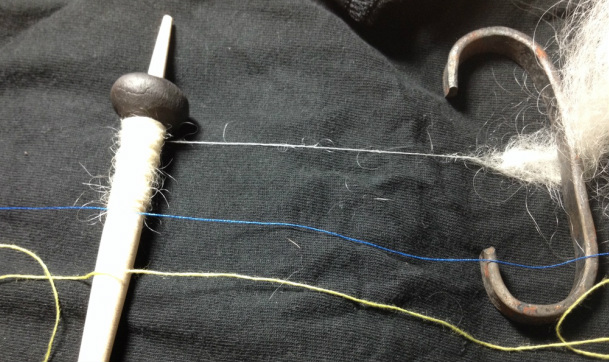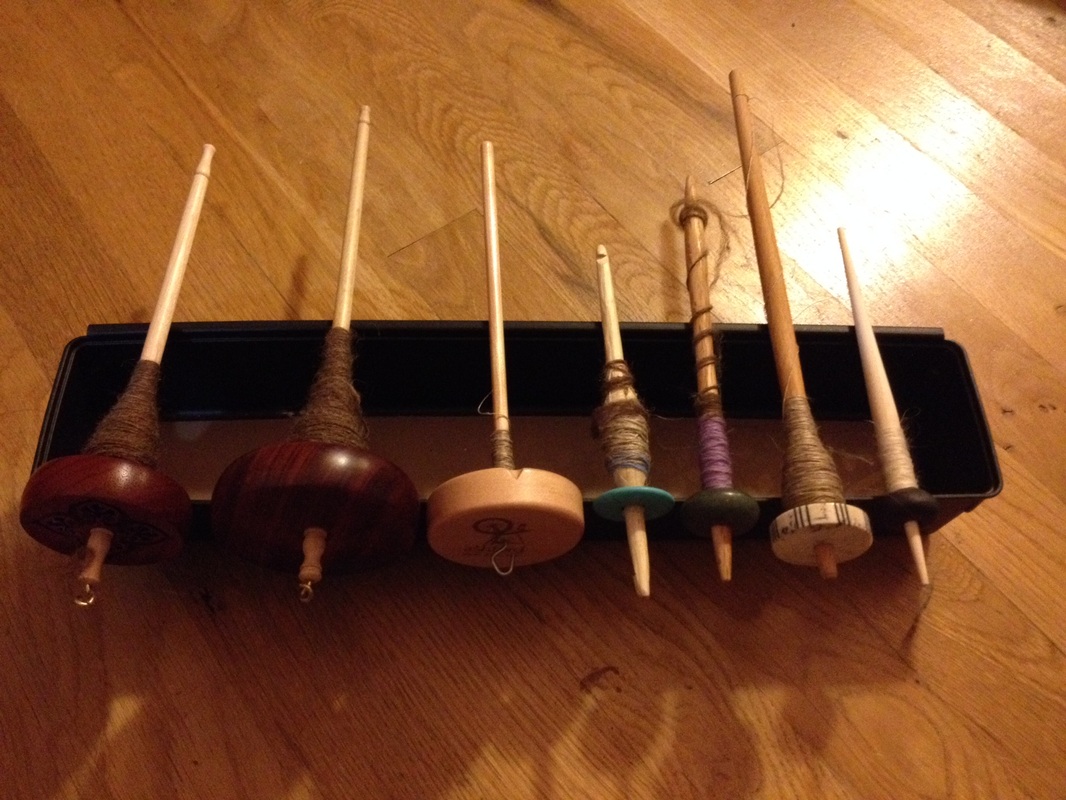As a spinner and weaver, the very high thread counts in some of the extant fabrics makes my head spin. Some of the "Birka Type" diamond twills found at Ribe had 24-62 warp ends and 15-25 weft picks per CENTIMETER. (Bender Jorgensen, 62) That is a very, very fine piece of weaving.
And fine weaving, of course, requires fine spinning. While I am nowhere near an expert spinner (having only been spinning since Pennsic 41), I can produce the equivalent of a 6/1 wool with some ease using a drop spindle. When weaving with a wool of similar weight I was working at 20 ends per inch, and while I could have packed in a few more threads per inch for a more dense cloth, it is still nowhere near the refinement of the Birka fabrics (or many of the others).
I can spin a uniform thread a bit more fine with my spinning wheel, but not with hand combed Icelandic or Spaelsau and even with a commercially processed top it is not as fine as the extant fabrics suggest.
I started to think about what was wrong... my fiber, my technique, my tools? All of these? I have a large assortment of spindles, including several that are quite light weight. But none would allow me to create the thread I wanted. I recalled something Mistress Rhiannon said in one of her spinning classes at Pennsic 42. We worked some with very large hand spindles to create a thick, lofty wool yarn and she mentioned something about medieval women using spindles in-hand. I started to wonder if I needed to use a supported form of spinning to produce an exceptionally fine thread but I had not yet had time to test out the idea.
The idea recurred to me as I was beginning to search for tutorials on how to spin flax. I came across two different things that made me further consider that concept of supported spinning. One is a video of Norman Kennedy spinning flax thread (https://www.youtube.com/watch?v=FOk8vLgxfgE ) and the other was a fascinating blog and articles about 15th Century spinning (http://cathelinadialessandri.wordpress.com/spinning/). This left me wondering more about the process of supported spinning and if that was not, perhaps, how Viking women created their yarns.
Certainly my own experiences with reproduction spindles would not let me produce satisfactory yarns via drop-spinning. The small low whorls had a tendency to spin very rapidly for a few seconds, then stop and backspin before I could stop it making the whole process rather nerve wracking. I opted, only out of stubbornness, to again try one of the most attractive spindles in my collection, when I first attempted to spin flax a few weeks ago. This is a spindle from Feed the Ravens with a Sami reindeer antler whorl. The first few yards was clumsy, but once I got the flax fiber drawn out so that the yarn I was spinning was exceptionally fine, the spindle behaved beautifully. The spin was fast, but long, and there was no abrupt stop with backspinning that I had noticed when spinning wool. I had come to a revelation that perhaps spindles and whorls could be far more specialized in their purpose than I originally thought.
Things were made much more clear to me when recent research for something else to read "Textile Production at Birka" from NESAT 7. In this article Eva Andersson references the spinning studies done by Anne Batzer at Leijre. She stated that the only spindle capable of producing a worsted yarn of the finer period textiles had a 5 gram whorl and a spindle no more than 12cm long. Further noted was the fact that that spindle was incapable of producing heavier yarns. (Andersson, 47) Also mentioned in NESAT 7, in Ryders article "Human Development of Different Fleece Types" he makes mention of spindles and whorls being specific to certain types fleece in addition to being specific to the weight of yarn being spun (he also mentions the option of supported spinning). (Ryder, 125)
All of these things set me to looking for a lightweight spindle and whorl. Both items were found (courtesy of a blog post by Lady Grazia Morgano) at shop in Germany carrying reproduction items for reenactors. (http://shop.pallia.net/index.php/en/) I purchased a 7 gram whorl and the smallest spindle shaft she sells (together they weighed only 19 grams) and at last was able to spin an exceptionally fine wool.
You can see in the image below that the white Spaelsau yarn on the tiny spindle (yes it is fuzzy, but I was doing this experiment quickly) is almost as fine as the blue thread below it. The blue is Gutterman sewing thread (standard machine thread). It measures aproximately .152mm. My white yarn was .279mm and the green below it is a commercial wool single for weaving that is .345mm. In Viking Age Headcoverings from Dublin, Heckett mentions threads as fine as .2mm and there is mention of threads as fine as .3mm from Merovingian finds. I feel like I finally have figured out that tools were one major factors that were limiting my ability to reproduce the fine yarns used to weave some of the more exceptional period textiles. (Note that I understand that Meroginvian is not Viking, but it is rare for any article to mention the diameter of the thread, as typically only the thread count is given. This article referenced both factors which helps me to get a better idea of the relationship between diameter and thread count for Viking textiles.)
The next spindle is an Ashford that was one of the first spindles I got. It is roughly 20 grams, and despite being lighter than the Feed the Ravens spindle, I had a terrible time spinning linen with it. (It worked excellently, however, for plying the yarn I spun on the Feed the Ravens spindle into a 2-ply sewing thread.)
The next is a hand carved spindle made by Mistress Rhiannon that also did not handle the linen well, but I suspect that is as much due to the whorl I used on it. I need to test it again with a different whorl at some point and see if I like that one better as I love it with an extant lead whorl for spinning heavier wool.
Beside that is a reproduction spindle with a soapstone whorl that I purchased a couple of years ago from Minerva's Spindle. I have yet to find the right fiber and yarn to make this one happy. I now look for ward to experimenting further.
The Feed the Ravens spindle is shown here with very fine linen on it. I am now completely in love with this spindle for the spinning of flax. The spindle and whorl weigh approximately 29 grams.
And at last, my new tiny spindle with a shaft of less than 7 inches and a 7.3 gram whorl. Together they weight 17 grams. I look forward now to testing this spindle with a variety of wools, as well as flax to see how fine I can spin a variety of fibers.
Resources
Andersson, Eva. "Textile production at Birka: household needs or organised workshops?", Northern archaeological textiles: NESAT VII: textile symposium in Edinburgh, 5th-7th May 1999.
Bender Jorgensen, Lise. "Textiles and Textile Implements," Ribe Excavations 1970-76, Volume 3, 1991.
di Alessandri, Cathelina. 15th Century Spinning website.
Heckett, Elizabeth Wincott. Viking Age Headcoverings from Dublin (Medieval Dublin Excavations series B) (v. 6), 2003.
Kennedy, Norman. "Spin Flax and Cotton with Norman Kennedy", Interweave Crafts https://www.youtube.com/watch?v=FOk8vLgxfgE.
Ryder, M.L. "The Human Development of Different Fleece-Types in Sheep and Its Association with the Development of Textile Crafts", Northern archaeological textiles: NESAT VII: textile symposium in Edinburgh, 5th-7th May 1999.
Vanhaeke, L. and C. Verhecken-Lammens. "Textile pseudomorphs from a Merovingian burial ground at Harmignies, Belgium", Northern archaeological textiles: NESAT VII: textile symposium in Edinburgh, 5th-7th May 1999.


 RSS Feed
RSS Feed